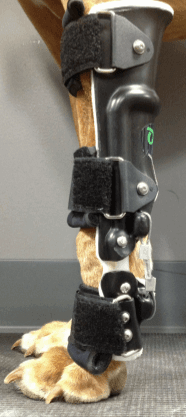Elliott and his OrthoPets Stifle-Tarsus-Paw Device (Dog Knee and Ankle Brace)

OrthoPets Case Study: Elliot
[caption id="attachment_3598" align="alignright" width="300"]

Initial delivery[/caption]Elliot, a 7.5 year old, neutered male, Bearded Collie, was presented to OrthoPets for fabrication of a custom orthosis to support a post-operative patellar tendon repair of the right hind limb. This patient was casted post-op to provide temporary stabilization. The goals for the orthosis were to rigidly stabilize the stifle in extension with the ability to allow motion over time for physical therapy and to encourage tendon healing while preserving the repair. The use of an orthosis was desired to facilitate daily range of motion exercises with the ability to immobilize the joint without having to re-cast on a daily basis.An orthosis to support a patellar tendon repair is a complex design requiring additional componentry for stabilization, force distribution, suspension and eventual[caption id="attachment_3599" align="alignright" width="300"]

Dynamization[/caption]dynamization. Device suspension is often challenging due to the limb being held in extension. The device design for this case included a cranial femoral shell segment, a cranial tibia and fibula shell segment and a caudal tarsus and paw segment. The stifle and tarsus joints are immobilized with metal bar stock. Dacron range of motion control straps were provided to the veterinarian in charge for the purpose of dynamization within the device system at a later time point. This componentry allows for both immobilization and restriction of joint range of motion at the stifle and tarsus. In addition, a neoprene tibial suspension sleeve was created for this patient, allowing for the recruitment of the calcaneus as an additional suspension location. The paw shell is an integral component as it resists gravitational forces to help unload the patellar tendon as well as assists in device suspension.When a patient is taken out of a cast and introduced to an orthosis, swelling and skinirritations are not uncommon. Bandages cause compression of soft tissues and[caption id="attachment_3600" align="alignright" width="300"]

Sports brace configuration[/caption]can restrict blood and lymphatic flow. When the bandages are removed, the changes in blood and lymphatic flow in combination with gravity can result in swelling and limb edema. This in combination with the requirement to wear the device 24/7 creates challenges that require dedicated owners. This patient initially required frequent air breaks from the orthosis, soft tissue massage and other rehabilitation techniques to resolve the edema of the distal limb segment. Of course the owners need to be aware that no weight-bearing can occur during these air breaks. Telfa pads were also initially recommended to cover and protect skin irritations on this patient.The patient's physical rehabilitation regimen was continued and the patient was allowed gradual dynamization of the stifle and tarsus. With time, the device was transitioned into a sports brace configuration for long term use via removal of the paw segment, custom modifications to the strapping and the addition of foam and friction reducing materials to maintain device integrity and increase patient comfort and functionality.
The use of the orthosis for post-operative support along with the dedication of the client, medical and rehabilitation teams resulted in a very positive outcome for this patient. Today, this patient has fully recovered and is pursuing an active lifestyle with no lameness or other signs of injury.



